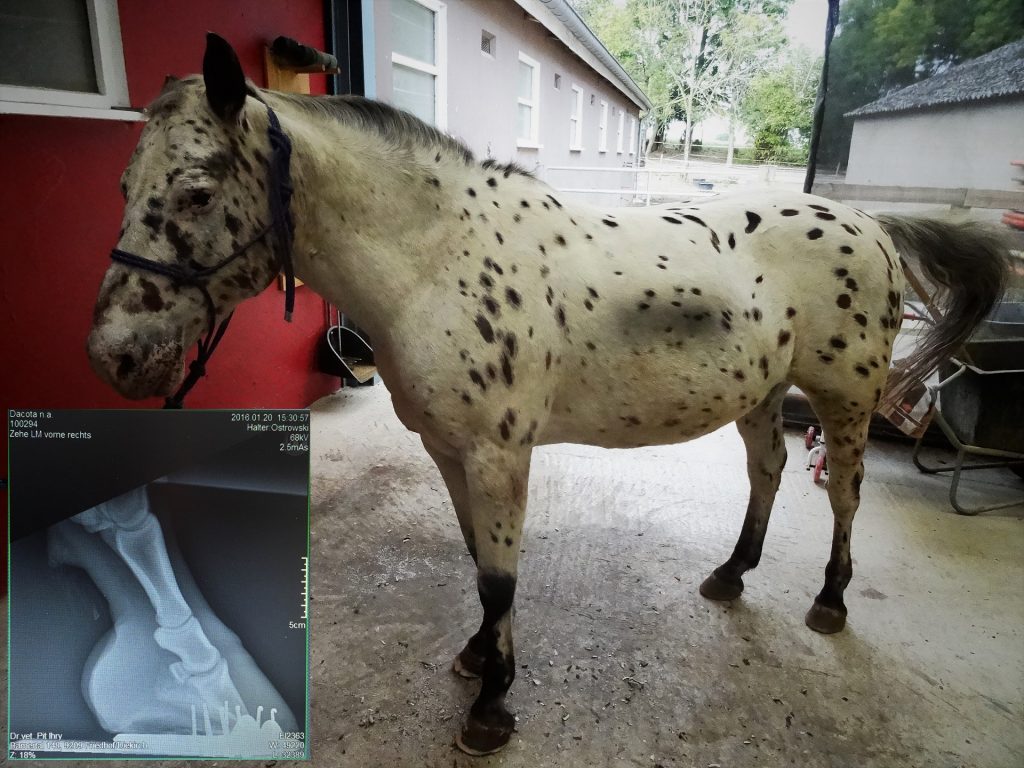I already talked about trimming horses with founder and how I could help a pony to feel better and start to walk correctly again in this article.
As time passed by, I have been entrusted with a couple of horses with severe founder, so severe that the farriers gave up on them and their respective vets advised both owners to put their horses down! I’m not writing this article to claim that trimming can save every horse. I’m writing this article to open all owners and riders eyes, hopefully they will TRY natural trimming before clinical death… we are talking about a lot of horses who could be saved, simply if horse people (owners, riders, farriers, vets) would accept the idea that maybe, sometimes, natural trimming can help!
Dakota, the horse who has been offered a second life
In 2015, I had the opportunity to take care of a horse called Samba (I will tell more about her later in this article), who was in an advanced state of founder. Her owner then introduced me to a lady who was desperate about her own horse: Dakota.
Dakota too was affected by a severe case of laminitis. I was explained that the veterinarian already advised to put him down as soon as possible because he was in too much pain. The farrier said he did all he could and Dakota was then wearing therapeutic horse shoes. After the hours I spent reading and watching Pete Ramey, and the weeks I spent trimming dozens of horses with different problems, although I certainly do not claim to have become a specialist, I knew enough to think that Dakota had a good chance to leave that founder behind him. Of course, that would not be done within a couple of weeks, it would demand dedication from his owners, but I was quite convinced he could make it.
Both Dakota’s front feet were deformed by founder: 18% deviation in the right foot and 17% in the left. On May 2, 2016 when I met him for the second time and for his first trimming session, walking on hard ground was very difficult and even painful to watch. I met with the farrier who removed the shoes and I took the following pictures:
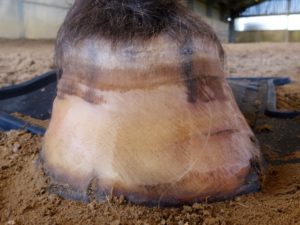
May 2, Left front hoof
Front
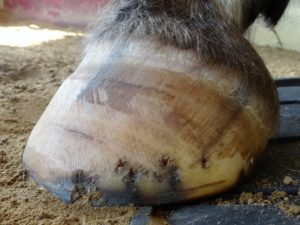
May 2, Left front hoof
Side
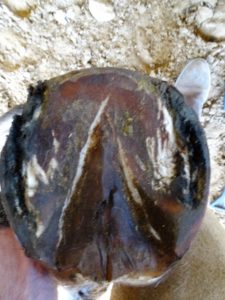
May 2, Left front hoof
Sole
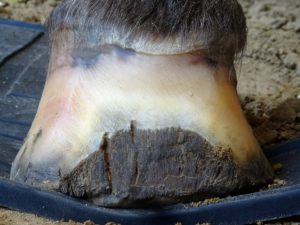
May 2, Right front hoof
Front
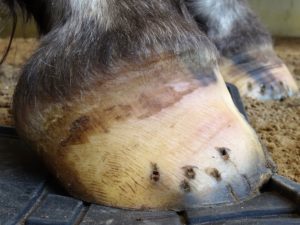
May 2, Right front hoof
Side
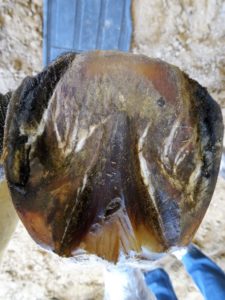
May 2, Right front hoof
Sole
As you can see, the classic approach consists in nailing metal under the hoof and basically cut everything around. Dakota actually missed a whole chunk of hoof capsule in front of the right feet, supposedly to release pressure.
Applying Pete Ramey’s instructions, I helped the hooves to grow correctly again. After five months of regular trimming (every three weeks in average), both hooves looked a little better. Dakota was not limping anymore and could walk on hard grounds again:
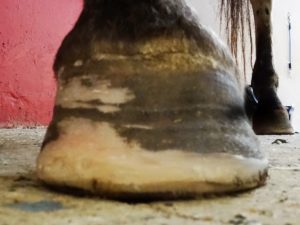
October 8, Left front hoof
Front
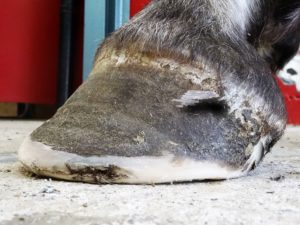
October 8, Left front hoof
Side
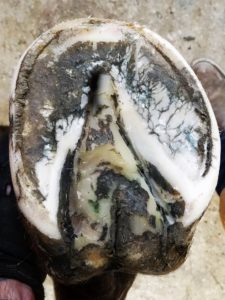
October 8, Left front hoof
Sole
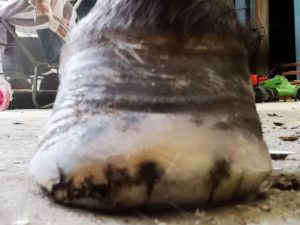
October 8, Right front hoof
Front
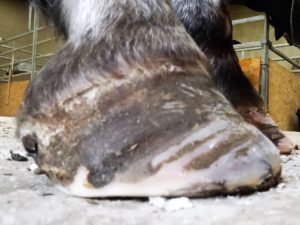
October 8, Right front hoof
Side
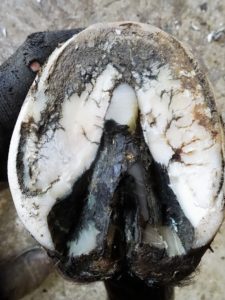
October 8, Right front hoof
Sole
It took another six months to obtain more viable results. Both hooves recovered a sound shape, Dakota was feeling a lot better, he was back to work on the ground at all gaits:
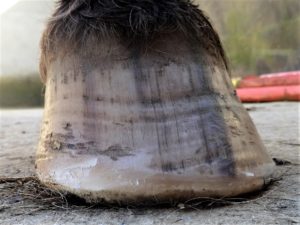
March 2, Left front hoof
Front
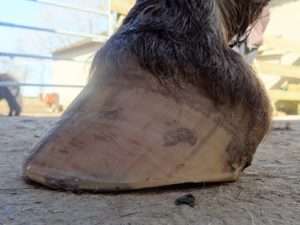
March 2, Left front hoof
Side
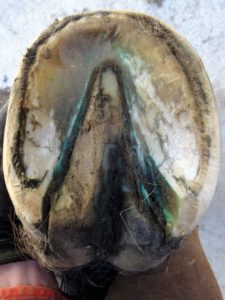
March 2, Left front hoof
Sole
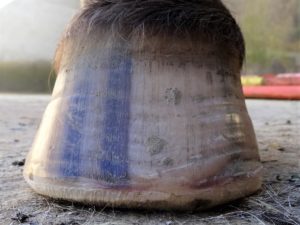
March 2, Right front hoof
Front
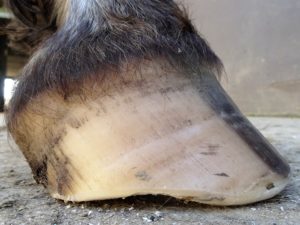
March 2, Right front hoof
Side
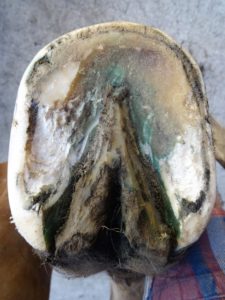
March 2, Right front hoof
Sole
Finally, after explaining the trimming routine to an open-minded farrier, Dakota has definitely beaten laminitis. Deviation was reduced to 5% in the right foot and only 2.4% in the left!
I also learned later that he was back under saddle during that summer 2017, enjoying horsemanship with his owner again after a long while…
Samba, living with founder
This mare was suffering from laminitis for years when I met her for the first time. Same conclusion as for Dakota although reached by another veterinarian: it was time to kill Samba to shorten her sufferings…
Even though I had my doubts, after I talked with her owner, we decided to give her one more chance: natural trimming! I started in November 2015. At that time, the mare was often drugged to ease the pain, and to be able to walk. Both front feet were deformed heavily, in particular the left front foot:
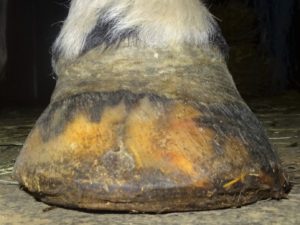
November 13, 2015
Front
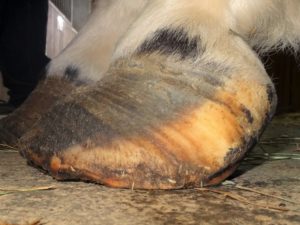
November 13, 2015
Side
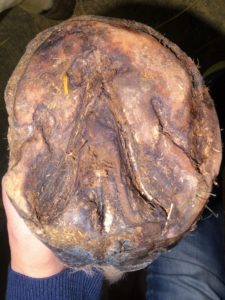
November 13, 2015
Sole
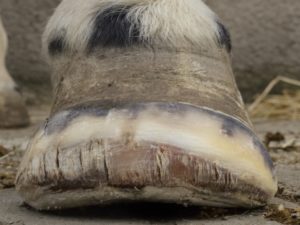
May 7, 2016
Front
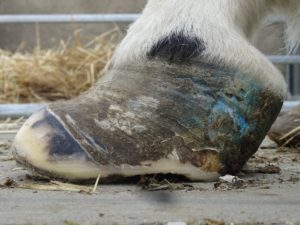
May 7, 2016
Side
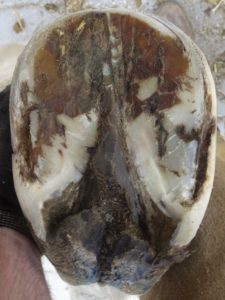
May 7, 2016
Sole
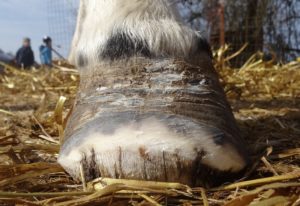
March 11, 2017
Front
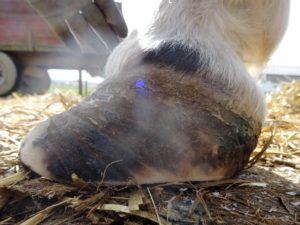
March 11, 2017
Side
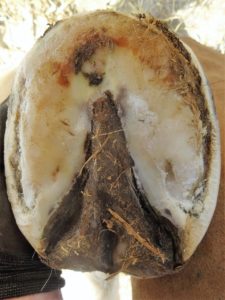
March 11, 2017
Sole
After a little less than a year and a half of regular trimming, the situation was better indeed, Samba did not need drugs anymore and could walk quite well, yet her feet were too damaged internally to grow back correctly. In Samba’s case, natural trimming has been a solution to reduce pain, to help her walk again and continue to live a “normal” retirement. But, within the limits of my skills, it was not enough to cure her completely.
* * *
As you see, many horses can be saved from laminitis, yet I would lie if I said that all horses can. Some, if diagnosed too late or not trimmed correctly in time, may have to live the rest of their lives with founder. A minority will have to be put down unfortunately.
First, I do advise all horse owners to be careful with the type of life they offer to their companions:
- even though it might sound nice and friendly to offer a shelter to your horse, you should not keep them in boxes every day all year long… they need to walk, a lot! Walking is the best way to prevent laminitis as it activates internal tissues,
- even though it might sound nice and friendly to protect your horse’s feet, you should not nail iron plates under its feet… this is just torture if you take the time to think about it and 95% of our horses do not do enough activities on concrete to actually need such protection! Hooves need to remain free in order change shape when horses move around, this is what helps blood to circulate in the legs,
- even though it might sound nice and friendly to feed your horse with carrots and apples and sugar and biscuits and cereals and candies and whatever else, you should not feed them anything else than hay or grass (dry, scarce grass, not green, fat, cow grass)… horses are not humans and their digestive system is not working like ours! Please, take the time to read more about horses natural habitat and feeding routines to respect their digestion, as too much carbohydrate will simply ruin it and have dramatic consequences on their health.
Second, whenever you suspect founder (basically whenever the growing line of a hoof’s capsule is not straight from top to bottom), you may want to consult a specialist in natural trimming to help your horse grow a sound hoof again. Don’t wait until it’s too late!

 ENGLISH
ENGLISH DEUTSCH
DEUTSCH ESPAÑOL
ESPAÑOL FRANÇAIS
FRANÇAIS